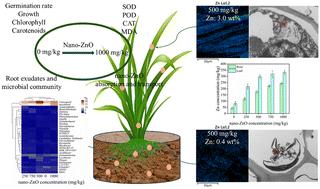当前位置:
X-MOL 学术
›
Environ. Sci.: Nano
›
论文详情
Our official English website, www.x-mol.net, welcomes your
feedback! (Note: you will need to create a separate account there.)
Effects of varying nano-ZnO concentrations on the physiology, biochemistry, root exudate, and root microbial community of Agrostis stolonifera
Environmental Science: Nano ( IF 5.8 ) Pub Date : 2024-09-25 , DOI: 10.1039/d4en00584h Yian Wang, Ronghui Wang, Jiale He, Tao Li, Xinyue Fu, Jiaxin Li, Genhe He
Environmental Science: Nano ( IF 5.8 ) Pub Date : 2024-09-25 , DOI: 10.1039/d4en00584h Yian Wang, Ronghui Wang, Jiale He, Tao Li, Xinyue Fu, Jiaxin Li, Genhe He

|
Nanomaterials find widespread applications, but their potential harm to the environment and ecology necessitates effective recycling methods. In this study, the effects of varying nano-ZnO concentrations (0–1000 mg kg−1) on the Agrostis stolonifera's physiological and biochemical parameters, root exudation, and root-associated microbial communities were systematically examined. At concentrations below 500 mg kg−1, nano-ZnO facilitated growth in root and leaf tissues. Conversely, higher concentrations led to a reduction in chlorophyll a, chlorophyll b, and carotenoid levels, potentially impairing photosynthetic efficiency. Concurrently, malondialdehyde levels in leaf tissues escalated with increasing nano-ZnO concentrations, while the activities of peroxidase, superoxide dismutase, and catalase initially increased before diminishing. SEM-Mapping and TEM analyses substantiated the transport of nano-ZnO within Agrostis stolonifera. At a concentration of 500 mg kg−1 nano-ZnO, root and leaf tissues contained Zn at levels of 0.4 wt% and 3.0 wt%, respectively. Notably, increases in zinc accumulation within both root and leaf tissues correspond with escalating concentrations of nano-ZnO. High concentrations of nano-ZnO reduce the diversity of root exudates and modify the structural characteristics of the root microbial community. Conversely, a lower concentration of nano-ZnO (250 mg kg−1) is associated with an increase in root species richness and diversity, as well as a heightened relative abundance of Gemmatimonas, Bradyrhizobium, Bryobacter, and Ammoniphilus. This study is the first report to provide critical insights into nano-ZnO behavior in Agrostis stolonifera and underscores the necessity for further investigations to elucidate root secretion mechanisms and microbial community dynamics.
中文翻译:

不同浓度纳米ZnO对剪股颖生理生化、根系分泌物及根系微生物群落的影响
纳米材料有着广泛的应用,但它们对环境和生态的潜在危害需要有效的回收方法。本研究系统地研究了不同浓度的纳米ZnO(0-1000 mg kg -1 )对匍匐剪草生理生化参数、根系分泌物和根部相关微生物群落的影响。当浓度低于500 mg kg -1时,纳米ZnO 促进根和叶组织的生长。相反,较高的浓度会导致叶绿素 a、叶绿素 b 和类胡萝卜素水平降低,可能会损害光合作用效率。同时,叶组织中的丙二醛水平随着纳米ZnO浓度的增加而升高,而过氧化物酶、超氧化物歧化酶和过氧化氢酶的活性先增加后减弱。 SEM 绘图和 TEM 分析证实了纳米 ZnO 在Agrostis stolonifera内的传输。在500 mg kg -1纳米ZnO浓度下,根和叶组织的Zn含量分别为0.4 wt%和3.0 wt%。值得注意的是,根和叶组织中锌积累的增加与纳米氧化锌浓度的增加相对应。高浓度的纳米氧化锌降低了根系分泌物的多样性,改变了根部微生物群落的结构特征。 相反,较低浓度的纳米ZnO(250 mg kg -1 )与根系物种丰富度和多样性的增加以及宝石单胞菌属、慢生根瘤菌属、苔藓杆菌属和嗜氨菌属的相对丰度的增加有关。这项研究是第一份对Agrostis stolonifera中纳米 ZnO 行为提供重要见解的报告,并强调了进一步研究以阐明根分泌机制和微生物群落动态的必要性。
更新日期:2024-09-30
中文翻译:

不同浓度纳米ZnO对剪股颖生理生化、根系分泌物及根系微生物群落的影响
纳米材料有着广泛的应用,但它们对环境和生态的潜在危害需要有效的回收方法。本研究系统地研究了不同浓度的纳米ZnO(0-1000 mg kg -1 )对匍匐剪草生理生化参数、根系分泌物和根部相关微生物群落的影响。当浓度低于500 mg kg -1时,纳米ZnO 促进根和叶组织的生长。相反,较高的浓度会导致叶绿素 a、叶绿素 b 和类胡萝卜素水平降低,可能会损害光合作用效率。同时,叶组织中的丙二醛水平随着纳米ZnO浓度的增加而升高,而过氧化物酶、超氧化物歧化酶和过氧化氢酶的活性先增加后减弱。 SEM 绘图和 TEM 分析证实了纳米 ZnO 在Agrostis stolonifera内的传输。在500 mg kg -1纳米ZnO浓度下,根和叶组织的Zn含量分别为0.4 wt%和3.0 wt%。值得注意的是,根和叶组织中锌积累的增加与纳米氧化锌浓度的增加相对应。高浓度的纳米氧化锌降低了根系分泌物的多样性,改变了根部微生物群落的结构特征。 相反,较低浓度的纳米ZnO(250 mg kg -1 )与根系物种丰富度和多样性的增加以及宝石单胞菌属、慢生根瘤菌属、苔藓杆菌属和嗜氨菌属的相对丰度的增加有关。这项研究是第一份对Agrostis stolonifera中纳米 ZnO 行为提供重要见解的报告,并强调了进一步研究以阐明根分泌机制和微生物群落动态的必要性。


















































 京公网安备 11010802027423号
京公网安备 11010802027423号